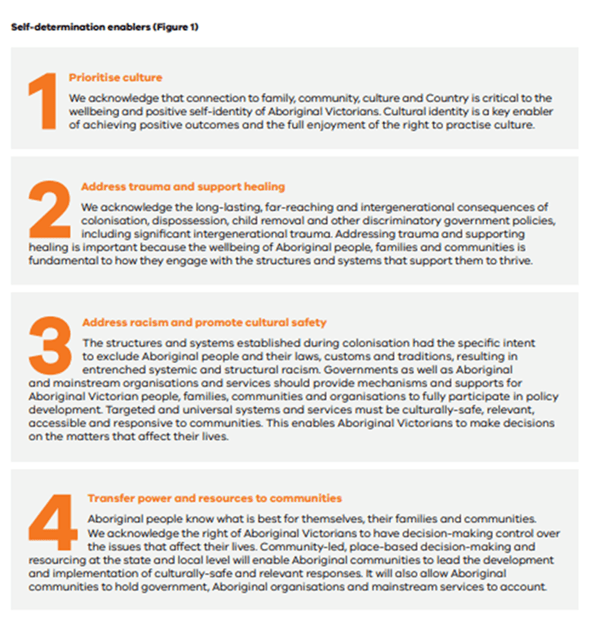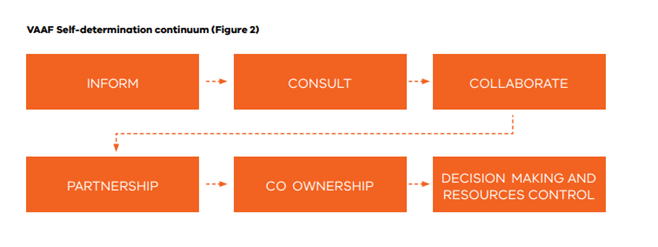Self-determination is key to improved outcomes for Aboriginal Victorians. It is a human right enshrined in the United Nations Declaration on the Rights of Indigenous Peoples and is a guiding principle under the Advancing the Treaty Process with Aboriginal Victorians Act 2018. The SDRF was developed in 2019 to embed government’s commitment to self-determination across all areas of government, and to help fulfil the ambitious and forward-looking agenda of the VAAF.
All government departments and agencies are required to report annually on what they are doing to action the VAAF’s four self-determination enablers (Figure 1).
Annual reporting aims to measure where on the VAAF self-determination continuum (Figure 2) our actions are landing and invoke reflection on how to move further along that spectrum. Departments demonstrated good progress towards supporting self-determination in 2022, including through identifying and removing barriers that keep First Peoples from exercising their right to self-determination.
Government action under the four self-determination enablers
Prioritise culture
Colonisation imposed settler laws and policies on Aboriginal people with the deliberate intent of excluding their lore, customs, cultures and traditions. The impacts of these laws and policies are still felt today.
Prioritising culture across government’s policies, programs and services ensures Aboriginal people can continue to share pride in their identity. Prioritising culture is also key to creating culturally safe workplaces, policies, programs and services. During 2022, departments demonstrated a strong commitment to making culture a priority in policy, program and service delivery.
Address racism and promote cultural safety
To advance self-determination, government must ensure that its systems and funded services are culturally safe, relevant, accessible and responsive. Government must also acknowledge and act to overcome racism, unconscious bias and discrimination in government laws, policy, practice, systems and institutions. Systemic racism and unconscious bias are primary contributors to social and economic disadvantage, such as the over-representation of Aboriginal Victorians in the criminal justice and child protection systems.
Government organisations have gone some way in transforming services to being culturally safe and responsive. Rolling out cultural awareness training, engaging in collaborative partnerships and workforce development initiatives contribute to creating a culturally safe environment where government engages with Aboriginal Victorians in a respectful and inclusive way.
Address trauma and support healing
Supporting healing is fundamental to the wellbeing of Aboriginal people, families and communities. This begins with acknowledging past and ongoing trauma caused by colonisation, disruption of culture, dispossession of land, forced child removal and other discriminatory policies. Central to this is government’s genuine and transparent engagement with the truth-telling process of the Yoorrook Justice Commission (Commission). Domain 5 of this Report highlights some of the progress that has been made by the Commission. Government must also continue to reform discriminatory laws, embed trauma-informed policies and programs, and develop new relationships of trust with Aboriginal communities.
Transfer power and resources to communities
Treaty will be Victoria’s primary vehicle to transfer decision making power and resources to communities. As detailed under Domain 6 of this Report, the Treaty process has achieved significant milestones in 2022. Victoria is preparing to embark on the next phase of the landmark Treaty process and commence formal Treaty negotiations in late 2023. More broadly, the Victorian Government is taking action to transfer power and resources back to communities, including strengthening structures that empower Aboriginal people and communities to share decision-making authority, providing funding to Traditional Owner Corporations, progressing agreements with Traditional Owners, and transferring resources to ACCOs to support service delivery.
Specific examples of government actions to enable self-determination reform can be found under the relevant VAAF domain in this Report.
Updated



